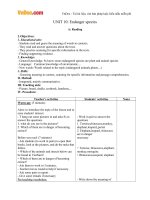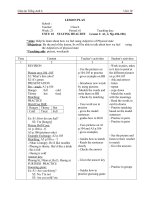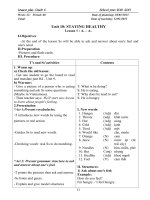Giáo án Tiếng Anh 12 unit 10: Endangered species
Bạn đang xem bản rút gọn của tài liệu. Xem và tải ngay bản đầy đủ của tài liệu tại đây (125.47 KB, 12 trang )
GIÁO ÁN ENGLISH 12
Unit 10 :
Endangered species
A. Language skills
1. Reading:
- To help students gain some knowledge about endangered species
- To help students improve their reading skills: scanning and skimming,
guessing the meaning of words in context.
Students learn words and phrases in terms of plants and animals.
2. Speaking:
- Students can ask and answer about a picture .
- Students learn more words and phrases in term of plants and animals
3. . Listening:
- Students can improve their listening skill : they can understand the passage
and then they can summarize the passage that they have listened to.
- Students learn more words and phrases in term of plants and animals
4. Writing:
- Students can write a report basing on the information given in the Table of
the Sahara desert
B. Language focus
1. Pronunciation:
- Rhythm
2. Grammar:
- Students know how to use Modal verbs : may , might, must mustn't , needn't
A. Reading
Aims
- To help students gain some knowledge about endangered species To help
students improve their reading skills: scanning and skimming, guessing the
meaning of words in context.
- Students learn words and phrases in terms of endangered species
Aids
- English textbook for students
- English textbook for teachers
- Pictures
Procedures
Stages
Prerea
din
g
(4min)
Teacher’s activities
- Greet Ss
- Ask students to look at the picture
page 99 and ask Ss to answer some
questions:
1 Which of the folloing animals and
insects are found in Vietnam ?
2 Which of them is / are in danger ?/
- Call a pair to report their discussion
- Introduce the topic:
Endangered species
While- - Teach some new words: ask students
reading whether they know the words, if they
( 30 min.) do not know them, explain in English
then ask them to give Vietnamese
equivalents to check their
understanding
- rhinoceros
- leopard
- parrot
- impact
- enact
-vulnarable
Task 1
- poriority
( 8 min.)
- derive from
- habitat
- Let the whole class read the new
words twice or three times.
- Call 2-3 students to read new words
again.
- Ask students to read the passage in
silence
- Ask students to do Task 1: Give
Vietnamese equivalent words to ones
given in the passage
-Ask students to discuss the answers in
pairs.
- Check Ss’ answer
Task 2
Students’ activities
-Greet teacher
- Listen to the teacher and think
about the topic.
- Answer teacher’s questions in
pairs
- Give Vietnamese equivalents
- Read the words
- Read the passage in silence
- Do task 1
Answer :
1- 1 d
22e
33a
44b
55c
( 10 min.)
- Write down the answers and
read the words
- Do task 2 in pairs
Task 3
( 7 min.)
Postreading
( 11 min.)
- Give the answers:
1. d
2. b
- Write down the answers on the board 3. a
- Let the whole class read the new
4a
words twice or three times.
5. d
- Call 2-3 students to read new words
again.
- Do the Task in pairs
- Ask students to do task 2 in pairs
- Go around to supervise students if
necessary.
- Ask representatives of pairs to give
* Suggested answers:
the answers. If students’ answers are
right, repeat them, if not, give the right - Listen to the feedback and
answers.
correct their mistakes.
- Ask students to do task 3 in groups
- Go around to supervise students if
necessary
- Ask representatives of groups to
answer the questions. If students’
answers are right, repeat them, if not,
give the right answers
- Ask students to do After you read in
pairs, scanning the text to find
information to complete the note.
- Go around to supervise them. Note
down the serious and common
mistakes
- Call some pairs to read their note
- Give feedback and correct some
serious or common mistakes.
B. Speaking
I. Aims
- Students can ask and answer about endangered animals
- Talking about the information of some endangered animals.
II. Aids
- English textbook for students
- English textbook for teachers
III . Procedures
Stages
Prespeaking
( 5 min.)
Task 1
Teacher’s activities
- Introduce the lesson:
Today, we learn Unit 10: part B.
Speakin g(Write on the board the title)
- Ask students to look at Task 1
- Ask students to do Task 1; Ask and
answer the questions
1 How do you call ;Gau truc, Te
Giac ,
Ho , Voi ,in English
2 Where does each of them live ?
3 Which of animals can use as pets or
for food or medicine ?
4 Which of them is/ are in dangered ?
5 Can you guees the population of
each species ?
Students’ activities
- Listen to the teacher and write
the title in their notebooks.
- Look at Task 1
- Do Task 1
- Work in pairs and discuss in
about 2 minutes.
- Give comments, correct the common
mistakes after they finish.
While-
Ask sts to study the information in the Work in pairs
box
Word explanation
sp decline
ea swamp
ki bark
n
g
( 28 min.)
Task 2
- Let the whole class read the new
words twice or three times.
-Ask sts to work in pairs to ask and
answer questions about them
- Read the new words .
- Do Task 2 in groups
S1 Where do giant pandas live ?
S2 In bamboo forests
S1 What is the population of
pandas in the world?
S 2 Only about 600
- Call one student to repeat the
instruction to check whether they are
clear about what they have to do
- Go around to supervise them. Note
down serious and common mistakes.
Postspeaking
( 10 min.)
Task 3
- After about 3 minutes of discussion,
call some groups to report what they
have done.
- Ask the others to listen to their
friends
- Listen to students attentively and
pay attention to the mistakes they
have made
- After students finish, give them
comments: correct some
pronunciation mistakes they have
Work in groups : Take turn to
give an oral report on the
animals mentioned in task 2.
- Repeat after the teacher.
- One pair to role play in front
of the whole class.
- Listen attentively to their
friends’ dialogue and give
comments or ask questions.
made
- Read aloud the words and ask the
whole class to repeat.
- Call 1 pair to role play in front of the
whole class.
- Ask the others listen attentively to
Homework their friends’ dialogue and give
( 2 min.)
comments or ask questions.
- Call another group if there is enough
time.
- Give feedback and correct serious or
common mistakes.
- Prepare a presentation about the
information about animals
- Listen to the teacher and
correct the mistakes.
- Listen to the teacher and note
down homework
C.Listening
I. Aims
- Students can improve their listening skill: they can catch detail information
from the passage.
- Students can summarize the passage.
II. Aids
- English textbook for students
- English textbook for teachers
- Tapes and cassette
- Handouts
III. Procedures
Stages
Teacher’ activities
PreWarm up:
listenin Ask sts to dicuss and choose the
g
best answer
(6min.)
Aek sts to listen to the teacher and
repeat some new words in the book
Learners’ activities
Work in pairs
1A
2B
3D
4B
5C
Whilelistenin
g
(29min.)
Task 1
- Ask students to listen to the
passage the first time
- Read the passage twice
- Ask some students to give their
answers. If their answers are right,
repeat them; if not give the correct
answers.
Task 2
- Ask them to listen again the
second and the third time to finish
task 2:
Ask sts to complete the chart in the
book.
- Go around to supervise students if
necessary.
- Eliciting the answers from
students, if their answers are right,
repeat the answers, if they are
wrong, give them the answers:
- Listen to the passage and answer the
questions.
* Answers:
1A
2B
3D
4B
5C
- Listen again the third time to finish
the task.
1peaceful
2 plant-eating
3 a few females and their young
4 plants and afew insects
5 in trees
6 in grasses
7 forests being cut down
- If most students do not catch the
information for the questions, let
them listen again to the passage
once more.
Postlistenin
g
(10min.)
- Ask students to work in pairs to
work in groups
summarise the main ideas of the
passage using the information intask
1 and 2
- Go around to supervise them. Note
down serious and common
mistakes.
- Ask one group to report what they
have discussed
- Give comments after they finish
- Call another group if there is
enough time.
- Give feedback and correct serious
or common mistakes.
D.Writing
I. Aims
- Students can write a report basing on the information given to write about
measures to protect endangered species and possible results
- Students can improve their writing skill.
II. Aids
- English textbook for students
- English textbook for teachers
III. Procedures
Stages
Prew
r
it
i
n
g
(7min.)
Whilewriting
Teacher’s activities
Students’ activities
ask sts to speak something about some rare Listen and answer the
animals which are in dangered .
quetions
-Ask some questions ;
Why are they in dangered ?
-what about their habitats ?
- Are they in danger ofvanishing?
- Why are they in dangered of in
nanishing?
Task1
Ask sts to read task 1 carefully and then
(28 min.) suggest possible measures that should be
taken to solve the broblems
- In troduce the Red-List
-Raise people's wareness of conversation
needs.
- Develop wildlife habitat resernes
-Stop people from throwing rubbish in to
forests , cutting down trees, hunting
animals for food, fur, skin or otherproducts
Ask sts to do tak 1
.work in pairs
Discuss the given sollution
Task 2 Ask sts to read the given sollutions
again and then write a paragraph about
measures for protecting endangered
animals ( using the ideals discussed in
Task 1 . Begin your paragaph with.
There are anumber of measures tht should
be taken to protect endangered animals
Postwriting
( 10
min.)
- Write the description
- Listen to the teacher and
correct the mistakes.
- Go around to supervise them. Note down
serious and common mistakes
- Show and correct some common
mistakes.
- Ask students to revise their description.
- Ask students to hand in their work to
mark
- Revise their description.
- Hand in their work
E.Language focus
I. Aims
1. Pronunciation:
- Rhythm
2. Grammar:
- Students know how to modals verbs: may , might , must , mustn't , needn't
II. Aids
- English textbook for students
- English textbook for teachers
- Pictures
III.
Procedures
Teacher’s activities
Stages
Pronun - Introduce the lesson:
ciation Ask sts to practise reading the sentences
Students’ activities
- Listen to the teacher
- Listen to the teacher
(7min.) in the book (paying attention to the
stressed syllables )
- Read the second time for the students to
repeat.
- Ask 2-3 students to repeat, correct their
mispronounce.
Practice these sentences
- Read 2 times the sentences, and then let
the whole class read the sentences twice
or three times.
- Read the sentences
- Read the sentences twice or
three times.
- Read the sentences again
- Read the sentences in pairs.
Gram Exercise 1
mar
Explain how to use may,might, must't
- Give the answers
(38min. needn't
2 may, might wake
)
3 may , might bite
- Call some students to give their
4 may, might need
answers. If students’ answers are right,
5 may ,might slip
repeat them, if not, give the right answers
6 may ,might break
.
Exercise 2
Underline the correct altrmative in the
.
sences
Note : xplain how to use however
- Call some students to give their
answers. If students’ answers are right,
repeat them, if not, give the right answers
Go around to supervise them
Exercise 3
Add so , therefore , or however
Note The use of therefore
- Call some students to give their
answers. If students’ answers are right,
repeat them, if not, give the right answers
Go around to supervise them
- Ask students to do exercise 3
- Go around to supervise them
- Ask students to discuss the answers in
pairs.
- Call some students to give their
answers. If students’ answers are right,
repeat them, if not, give the right answers









